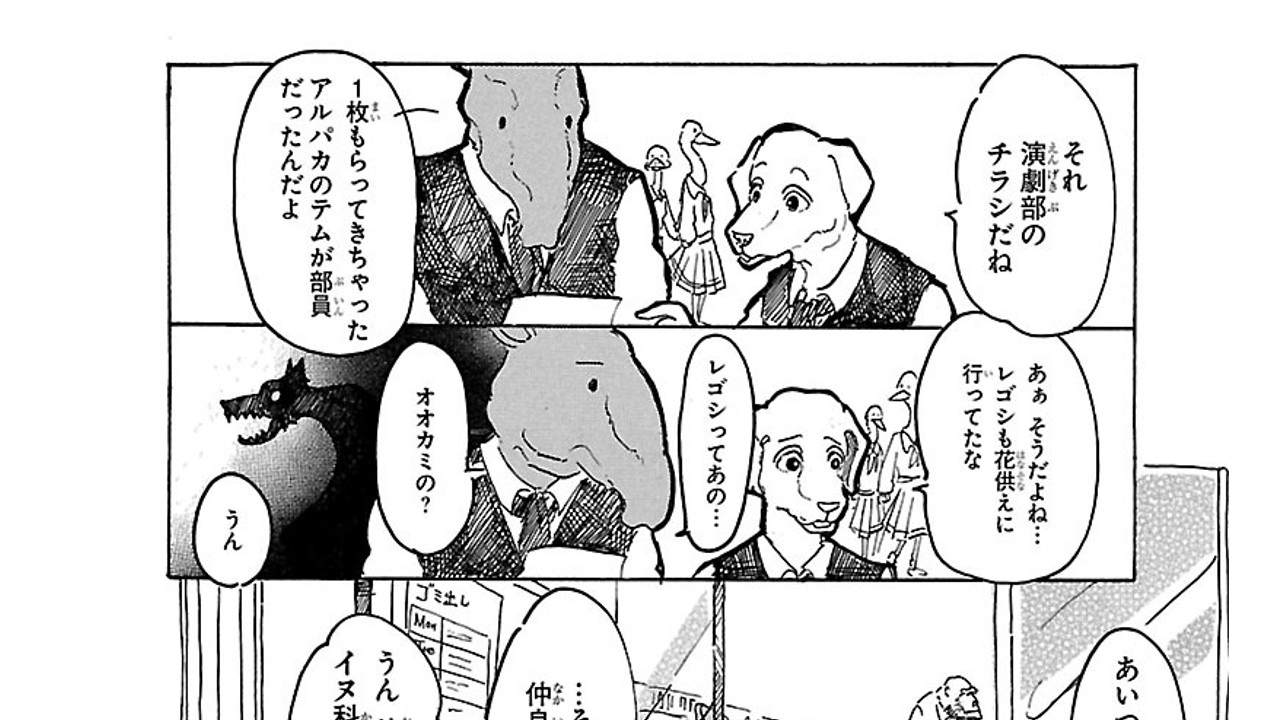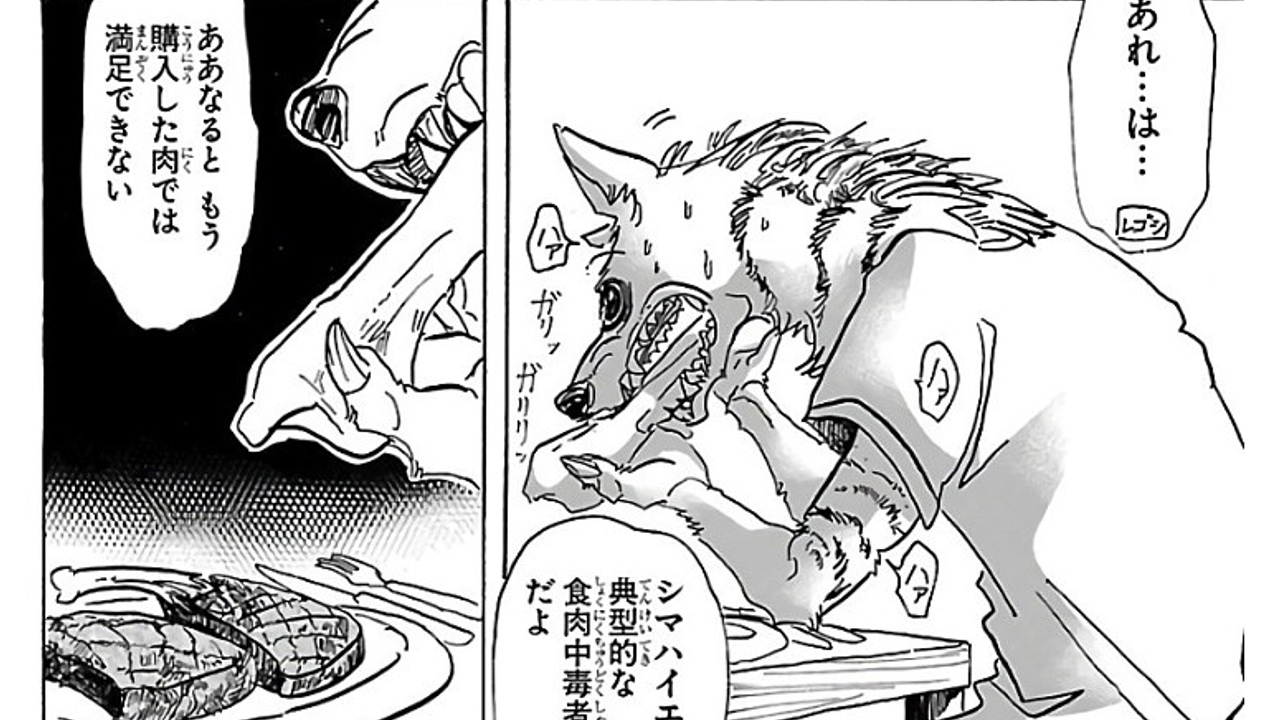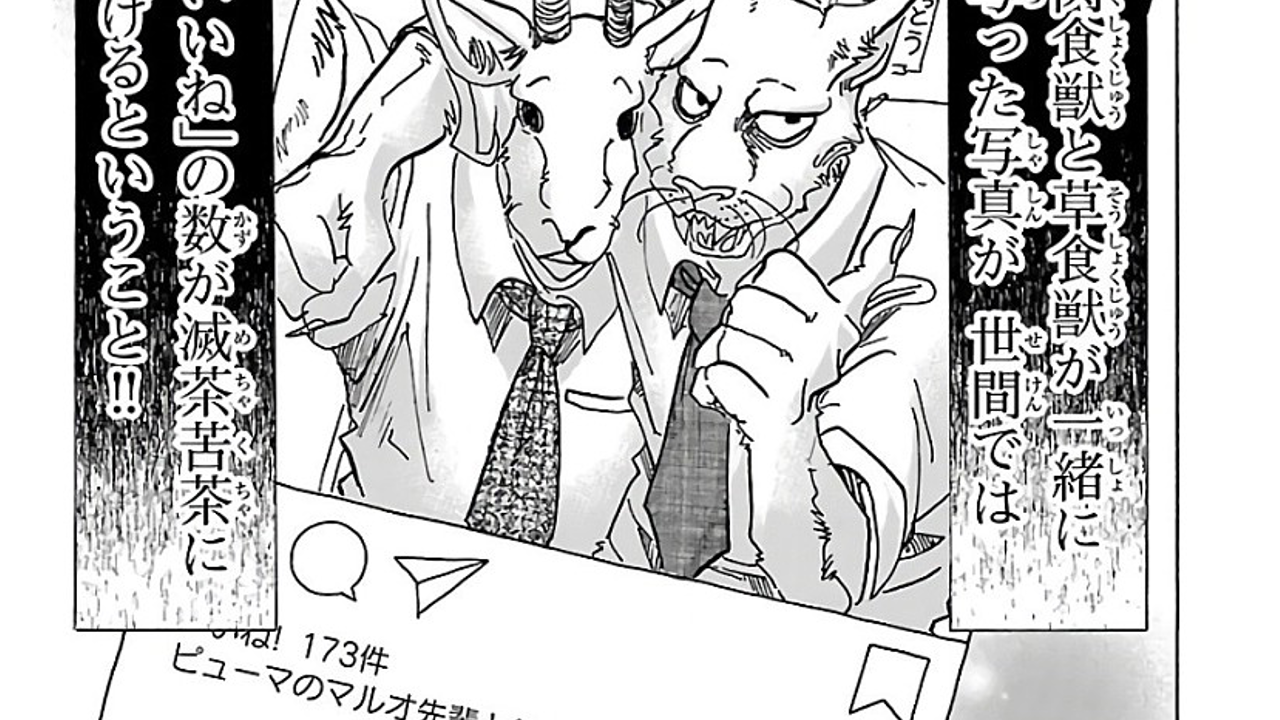BEASTARS Builds Empathy with Messy and Tangled Race Parables

BEASTARS is a shonen manga serialized in Weekly Shonen Champion. It stars a large cast of anthropomorphized animals who coexist in a society where the vast differences between various species are accounted for in many societal standards, rules, and laws. These laws help maintain order and attempt to enforce healthy lifestyles, but many times the laws are superficial and just dodge certain societal issues–similar to our own world where people may fall through cracks in healthcare, employment, and education. The animal cast of BEASTARS all have a diverse set of problems that differ greatly even between characters from the same species. The people (while not human I definitely call them people) we read about in the pages of this comic are very much molded by their labels, empowered and victimized.
As fiction dealing with anthropomorphized animals, and specifically being fiction dealing with heavy racial parables, it’s hard not to compare BEASTARS to the 2016 hit animated film Zootopia. The scope of these two stories are very different, but BEASTARS deals with the daily lives of highschool students and ends up being much more ambitious than Zootopia’s city wide (potentially world wide) conspiracy.
The main crux of this difference is the simple and clean depiction of the prey and predator parable for races in our world. Zootopia plays with the idea that carnivores are more violent and cannot be trusted to act civilized, riffing on age old scare tactics that exist in our world. This ends up being a hoax perpetrated by an Herbivore with a grudge against all carnivores. The morality here is clear and on purpose–it is a film for kids after all. Everyone is equal in their capacity for good and evil and labels are skin deep. This is an obvious choice when presenting a naked parable such as [Herbivore = White or majority class] and [Carnivore = People of Color or minority class.]
But BEASTARS is a little more nuanced with its world. These characters are actually animals, not just furry humans–meaning their bodies and temperaments are wildly different and potentially volatile when mixed. In BEASTARS’ world some people’s jaw strength can easily crush a body. Some species are strong enough to rip an arm out of a socket. Some of their senses are so acute that they can sniff out someone’s location from a long distance away, and instantly recognize if that person needs help, or is vulnerable. These are just some of the examples that address society’s attempts to deal with those realities within the BEASTARS’ world.

A dog named Jack is talking to his Herbivore friend after a recent murder at their school. Tensions run high because it is rumored to be a Carnivore Herbivore homicide.
Amputees are so common in this world (frequently accidental) that most characters know how to react if the situation arises, and most clinics have a specialist surgeon for such emergencies. Picture roughhousing with your friends and losing a limb, or the Public Service Announcements children of this world have to sit through to become familiarized with their other species’ frailties. Think about the inferiority complexes and fears they may grow up with–their biases clearly based on tangible danger and survival instincts. More importantly, imagine the guilt associated with severely maiming a friend, or the compulsion to be “one of the good ones”–to walk on eggshells because everything and everyone is made of cardboard.
Carnivores are very different than Herbivores and if you try and draw direct or wholistic parables to racial divides, it becomes very problematic very quickly. Instead it’s refreshing to embrace the differences between races and spin a story out of diversity in every sense. Various cultural groups differ from each other–in culture and upbringing, and in the ways they might react to certain situations. This doesn’t make one group superior to another, but pretending like race is a simple label and not an identity is toxic and dangerous. There’s a school of thought, a pseudo-tolerance that pretends there are no differences between races. These believers judge any problems or difficulties facing a people as purely their own doing and their own responsibility to solve. This pseudo-tolerance is usually quick to snuff out conversations about race, gender, or sexuality; claiming they are regressive or “race baiting.” BEASTARS’ world is built to accommodate diversity in biology, but not in sociology.
In that sense, it resembles our own world–any talk of the carnivorous urge to eat meat is grotesque and eating meat is probably the biggest taboo in this world. However, while eating meat is explicitly banned by law, it is a relatively common occurrence because of a thriving “Black Market” that seemingly operates as an open secret. While not explicitly stated, it is implied that most carnivores find themselves in the Black Market at one point in their life, just to experience the sights, smells and even taste of meat.
One of the darker revelations in BEASTARS(there are quite a few), is that meat eaten here has to come from somewhere and it’s not always animals who’ve died of natural causes. Although hospitals are implied to be a large supplier of meat, a significant portion of meat is provided by actual Herbivore trafficking. Frequently children are sold off to Carnivores to be a living, breathing meal. This is another muddying of the race parables: first, Carnivores are seen as PoC because of the stigmatization they encounter in society, and after these revelations, it’s not hard to see the Herbivores as the downtrodden class–literally kidnapped and sold off, some of them branded or tattooed with serial numbers. There’s no clear social engineering to solve these problems, just the horrible morality of the blind eye the world turns to this place.

Eating meet is illegal but Carnivores can have some if they go to the Black Market. Some become addicted to meat and might be driven to murder.
In the same arc that introduces the Black Market, you meet the Mayor of the City. He is a Lion that had his fangs filed down, as well as extensive facial surgery to make his face less predatory and palatable to the masses. This is the cruel dichotomy of the BEASTARS world that seems most prescient to our world. Diversity is attractive and coveted until it makes people uncomfortable or fearful; it’s easier to sweep under the rug than to engage–just as black athletes are cheered when performing, but demonized when they protest.
When taken at face value, a lot of this falls in line with more problematic race politics. The Herbivores are depicted as victims, when once they were easily interpreted as a White stand-ins. The cries of “reverse racism” are common in our human reality and BEASTARS’ sentiments play into the hands of the pseudo-tolerant who would want nothing more than to equate the suffering of Whites and Blacks in America. As stated before, the characters in BEASTARS are not Humans, but Animals–with their own history, culture, upbringing, and baggage. The creator of the series Paru Itagaki has even told fans that the Carnivore/Herbivore relationship isn’t meant to mirror Racial tension, specifically. Although the author is dead, (in a literary critique way–Paru Itagaki is thankfully still with us) it’s hard not to see the spirit of BEASTARS as an empathy building narrative. We are privy to some of these characters’ pasts, inner dialogue and feelings. We see how they are inexorably tied to their species, but wildly diverse, therein.
BEASTARS really nails PoC dialogue. It accurately portrays how we act when a white person is around and how we might relax once they leave. In a different story this would be taken as duplicitous and toxic, but in BEASTARS it is almost wholesome. It also does a good job of depicting PoC being weary and accustomed to racism. When a Carnivore reacts negatively to discrimination, while another accepts it as normal, it’s hard not to see myself in those positions. I’ve been in both situations and on both sides of the ensuing conversation. The slightly younger one who is shook and angry wonders whether or not she needs to become indifferent to discrimination. The older one tells her that she is right to be angry, and that it’s important to be frustrated by the situation. The Carnivores’ compulsions are very humanlike and very relatable for PoC, even when they don’t stand up for themselves.
Triumphantly, I feel BEASTARS understands interactions between Whites and PoC as well. Some of the closest relationships are between Herbivores and Carnivores. In fact the main romantic relationships are all interspecies. This doesn’t take away from the edge and the spirit of the comic’s identity-focused narrative.
One chapter covers a social media fad where Herbivores take selfies with Carnivores. These pictures always get a lot of likes and buzz, but the subjects of the photographs are rarely friends. Herbivores usually approach their Carnivore schoolmates or co-workers and ask for a group selfie. Usually flattered, the Carnivores accept, only to be later ignored by their would-be friends. These cute selfies that should symbolize love and togetherness are just performative gestures to get online notoriety.

A recent fad of Herbivores taking selfies with Carnivores creates some hurt feelings.
BEASTARS is a comic that frequently surprises me, and I tell you, when I came across a chapter about performative allyship/wokeness, I nearly flipped. But as little as I expected it, I knew it fit so well within BEASTARS. It’s important to note that a Carnivore and Herbivore, who were barely acquainted, become good friends in this chapter–not after taking a selfie, but after a lapse of decorum and a sharing of vulnerability. Bucking the usual trope of revealing these two are the same (save for the “skin-deep labels”), here they connect because of how different they are.
The protagonist of the series is a Grey Wolf named Legosi, and in a manga with dozens of stellar characters and plot revelations, Legosi is by far the most interesting. He has an extremely mellow and low-key personality and usually doesn’t like to stand out. In the start of the series he is seemingly above labels like Carnivore, or Predator. Legosi doesn’t subscribe to them, and doesn’t let people who hate him for it get to him. When his friends become threatened and peers are broken, Legosi ends up finding a new identity within his species, and he allows it to guide him into new frontiers. Being unlike any other Grey Wolf but strongly identifying with his own kind, is a beautiful character trait. It shows a deft touch in handling PoC characters, even if that’s not what Paru Itagaki was intending. Every pseudo-tolerant who refuses to acknowledge color because they claim they respect people too much to label them should read about Legosi. Honestly speaking, they should just befriend more PoC, but I think some of them are much more likely to read this manga than make the attempt.
This is one of the reason I want BEASTARS to be licensed so badly–there’s an undiscovered world of fans out there who would be touched by this story. There are very intelligent people, outside and inside of comic fandom, who can bring new and exciting critiques to this manga. There are marginalized people who are much wiser than I who can reinterpret this in ways I cannot. I’m very bad at talking about race and I’ve never felt comfortable doing it. If I’m honest, it’s likely one of the reasons I identified with Legosi so much.
Part of me does fear the potential negative interpretations that BEASTARS might generate. After all, its world features characters and races far stronger than others, and certain unscrupulous characters within the story see superiority in that difference. It’s not hard for me to imagine a Libertarian finding a parable to fit their world view, or White Supremacist finding a lot to like about BEASTARS–only if they ignore large parts of the plot and character dynamics–but that won’t stop em, I fear. Part of BEASTARS being so open-ended and ambiguous is that people will interpret the story as they want to.
I’ve written about very few details of the plot and only on my own experience reading this story. It’s important to note that this manga is currently on-going, but is not licensed in English. Various publishers have surveys and social media accounts, and if you’re at all interested in reading BEASTARS, it would be helpful to show interest to these parties.
~darfox8, with help from the Manga Mac crew
